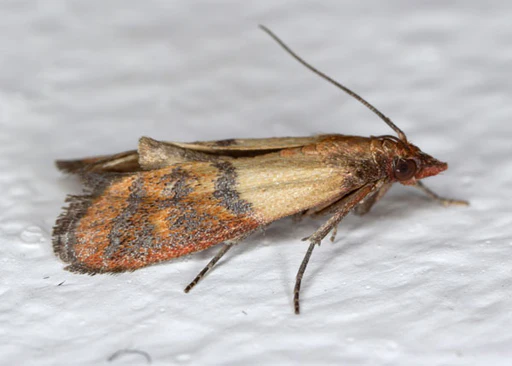Pantry moths are often ignored among household pests, but they can quickly multiply, resulting in a significant infestation. These small, unwanted visitors hide great potential for destruction to your stored food products by infecting them with their eggs, larvae, and webbing. If you’ve ever discovered small holes in your cereal boxes or seen little, grey moths flying in your kitchen, you should act now. This thorough manual will familiarise you with the seven predominant varieties of pantry moths and offer you successful tactics to stop and eradicate these annoying trespassers from your residence.
Common Types of Pantry Moths
Indian Meal Moth
The Indian meal moth is a tiny, brown pest found in households, measuring roughly ½ inch in wingspan. White caterpillars infest stored food items such as flour, cereal, pasta, and pet food. Active at night, they lay eggs on food or in cabinets, hatching into larvae that develop into adult moths. They contaminate food with webbing and excrement, causing spoilage. To eliminate Indian meal moths from your pantry, take prompt action.
Mediterranean Flour Moth
The Mediterranean flour moth is a prevalent insect that invades stored food items. Belonging to the Pyralidae family, they mainly focus on grain goods and have expanded worldwide because of their adaptable characteristics. The moths have bodies that are light brown and wings with dark brown markings, reaching lengths of up to 10mm. They are naturally active at night, eating and reproducing in darkness. Infestations can be identified by silken webs, larvae remnants, and live insects in food supplies. Preventive measures involve storing dried foods in sealed containers and regular pantry cleaning to eliminate breeding sites.
Angoumois Grain Moth
The Angoumois grain moth targets stored grains worldwide, especially wheat, barley, and corn. Small moths have light brown forewings, pale grey hind wings. The larvae can reach a length of up to 6mm and cause harm by eating inside grain kernels. Angoumois grain moths are most active in warm weather and complete their life cycle in about 30 days. Females lay eggs on grain surfaces, leading to larvae hatching and tunnelling into kernels. If infestation occurs, discard affected items and clean the storage area thoroughly.
Almond Moth
The almond moth, scientific name Cadra cautella, is commonly found in tropical regions. These small moths have pale straw-coloured front wings with black tips, and their wingspan ranges from 15-20 millimetres. Adult moths are usually found resting on the walls or ceiling near food sources. Larvae are light yellow in colour and leave silken threads as they crawl through food, and they usually infest dried fruits, nuts, chocolates, and other stored products. To prevent Almond moths, store food in airtight containers and ensure proper hygiene in the pantry.
Tobacco Moth
The tobacco moth, known as Ephestia elutella, is commonly found where? Yeah, in tobacco products, but it has also been discovered in stored grains and other food items. These moths display forewings in a dark brown or black shade with uneven light markings and have a wingspan of 14-18 mm. Larvae are typically a light shade, either white or pale brown, and have visible red or brown spots. They frequently create silk-like strands while feeding, which can contaminate food. Tobacco moths are drawn to dim, calm areas and can invade stored tobacco items, spices, grains, and dried fruits. Avoiding infestations can be achieved by practising proper hygiene, promptly eliminating infested items, and storing vulnerable products in containers that are airtight.
Raisin Moth
The Cadra figulilella, also known as the raisin moth, is a widely distributed species that is famous for its habit of infesting dried fruits, specifically raisins. The moths possess slender wings that seem to have a grey-brown hue with a dark band close to the edges of the wings. The wings of the insect span about 17-20 millimetres in length. The larvae of raisin moths can be either white or light yellow with darker heads, and they produce silk webs that may contaminate food. To avoid pests, keep dried fruits and other vulnerable items in airtight containers and maintain good pantry cleanliness.
Brown House Moth
Hofmannophila pseudospretella, also known as brown house moth, is frequently seen in bird nests, attics, and other dusty locations. Nevertheless, it is also capable of infecting stored food items such as cereals, grains, nuts, and spices. These small moths have wingspans measuring approximately 10-15 mm. Their bodies are elongated and have brown wings that could seem darker towards the ends. The larvae of brown house moths are white with light brown heads, and they invade food by creating silken tubes for protection.
Causes of Pantry Moth Infestations and Preventive Measures
Pantry moths are a persistent issue in homes, stores, and warehouses, endangering stored food; knowing causes aids prevention efforts. And what causes these pantry moth infestations? Well, there are several factors contributing to these infestations:
- Inadequate Food Storage – When it comes to long-term food storage use airtight glass, plastic, or metal containers with secure lids.
- Unintentional Introduction – Close doors and windows in the evening to deter pantry moths.
- Not Paying Attention – Check the pantry for infestation signs like webs, moths and larvae often.
- Infested Food Packages – Dispose of infested food in a sealed bag to prevent infestation spread.
- Lack of Pantry Hygiene – Clean pantry shelves, drawers, and cabinets often to avoid moth infestations.
- Lack of Measures – Strategic placement of moth traps prevents reproduction by attracting adult moths.
- Structural Vulnerabilities – Cracks, gaps and crevices must be fixed.
How to Handle Pantry Moth Infestations
Should you discover an advanced pantry moth infestation, containing the situation becomes paramount to prevent further spread and eliminate existing moths efficiently. Initiating a thorough pantry moth control serves as an effective starting point. Thoroughly inspect stored food, dispose of any compromised items, and watch for signs of infestation.
Dealing With Severe Infestations
For severe infestations, extensive moth control measures may be needed to eliminate the problem. Pheromone traps for pantry moths can effectively attract and trap male moths, halting breeding and slowing infestation spread. Insect growth regulators approved for household use are also beneficial. Using insect growth regulators (IGRs) that are authorised for household use can also be advantageous. IGRs disrupt the development of immature moths, effectively halting the infestation cycle.
Conclusion
Understanding pantry moth behaviour and implementing preventive measures is crucial to managing infestations. These include maintaining pantry hygiene, using airtight containers, inspecting for signs, and discarding compromised items. Severe infestations may require a thorough purge and using moth control measures like pheromone traps. Vigilance and quick action are essential for preventing and controlling pantry moths, preserving the quality and safety of stored food.











